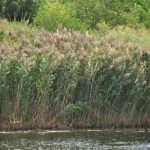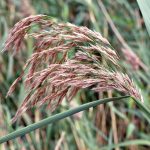Common Reed Grass/Phragmites
Identification:
A tall, perennial grass that can grow to over 15 feet in height. In North America, both native Phragmites and introduced subspecies are found. Introduced Phragmites forms dense stands that include both live stems and standing dead stems from previous year’s growth. Leaves are elongated and typically 1 to 1.5 inches wide at their widest point. Flowers form bushy panicles (branching clusters of flowers, as in oats) in late July and August and are usually purple or golden in color. As seeds mature, the panicles begin to look “fluffy” due to the hairs on the seeds and they take on a grey sheen. Below ground, Phragmites forms a dense network of roots and rhizomes which can go down several feet in depth. The plant spreads horizontally by sending out rhizome runners that can grow 10 or more feet in a single growing season if conditions are optimal.
The plants high biomass blocks light to other plants and occupies all the growing space below ground so plant communities can turn into a Phragmites monoculture very quickly. Phragmites can spread both by seed dispersal and by vegetative spread via fragments of rhizomes that break off and are transported elsewhere. New populations of the introduced type may appear sparse for the first few years of growth but due to the plant’s rapid growth rate, they will typically form a pure stand that chokes out other vegetation very quickly.
Control:
New stands of common reed can come about on soil that has recently been disturbed or polluted. Reducing the amount of disturbed soil, and pulling individual plants before they can become established is the best defense against this plant. Repeated mowing has been found to be effective as well, but in wetlands areas it is extremely difficult to remove established populations without major projects involving professionals and heavy equipment.



